Are you looking for an old silver coin? If yes, then you need to consider getting the 1955 silver quarter. In this post, you’ll learn more about the history, value, design, and composition of the 1955 silver Washington 25-cent.
What Is the 1955 Washington Silver Quarter Made Of?
The 1955 Washington silver quarter is made of 90 percent silver and 10% copper. It has a mass of 6.30 grams, which is heavier than the quarter coins today. Aside from that, this 25-cent coin has a diameter of 24.3 millimeters and its edge is reeded.
The 1955 silver quarter is part of the Washington quarter series, which was first struck in 1933. The history of the Washington quarter is quite fascinating.
Originally, Congress would like to add George Washington to the half-dollar coin, which at that time featured the Walking Liberty design. Later on, it was decided that the Washington design would be placed on the Standing Liberty quarter.
The Washington quarter should only serve as a commemorative coin as part of the bicentennial birth celebration of George Washington, the first president of the United States. However, the plan has changed because when the Washington quarter was issued, the general public liked the design so much. From there, the US Mint decided to permanently replace the Standing Liberty and from 1934 up to this day, the Washington quarter was continually minted.
The 1955 silver quarter features the image of George Washington. Above his head arches the word LIBERTY and below him, you’ll find the year of minting, which is 1955. Just below his chin, you’ll find the US motto, “IN GOD WE TRUST.”
On the reverse side of the coin, you’ll find an image of an eagle, a bundle of arrows, and an olive branch. Inscriptions include UNITED STATES OF AMERICA, E PLURIBUS UNUM, and quarter coin.
1955 Washington Silver Quarter Varieties
The 1955 Washington silver quarter has three standard varieties. The Denver and Philadelphia Mint worked together to produce more than 21 million silver quarters in 1955. The production slowed down and fewer quarters were made in this year compared to 1954 and 1956.
Here’s a quick look at the varieties and mintage of the 1955 Washington silver quarter varieties:
| Variety | Mint Location | Mintage |
| 1955 D Washington quarter | Denver | 3,182,400 |
| 1955 P Washington quarter | Philadelphia | 18,180,181 |
| 1955 Proof Washington quarter | Philadelphia | 378,200 |
| Total | 21,740,781 |
As you may have observed, the San Francisco Mint didn’t produce any quarter coin or any other types of coins. 1955 marked the year when the San Francisco Mint was closed.
With that, let’s take a look at the varieties of the silver quarter of 1955.
1955 D Washington Quarter
Year of minting: 1955
Mint Mark: D
Place of minting: Denver
Quantity produced: 3,182,400
Face Value: $0.25 (twenty-five cent)
Price: starts at around $4.45 and $7 (circulated condition)
Mass: 6.30 grams
Edge: Reeded
Designer: John Flanagan
Composition: 90% silver and 10% copper
Diameter: 24.30 millimeters
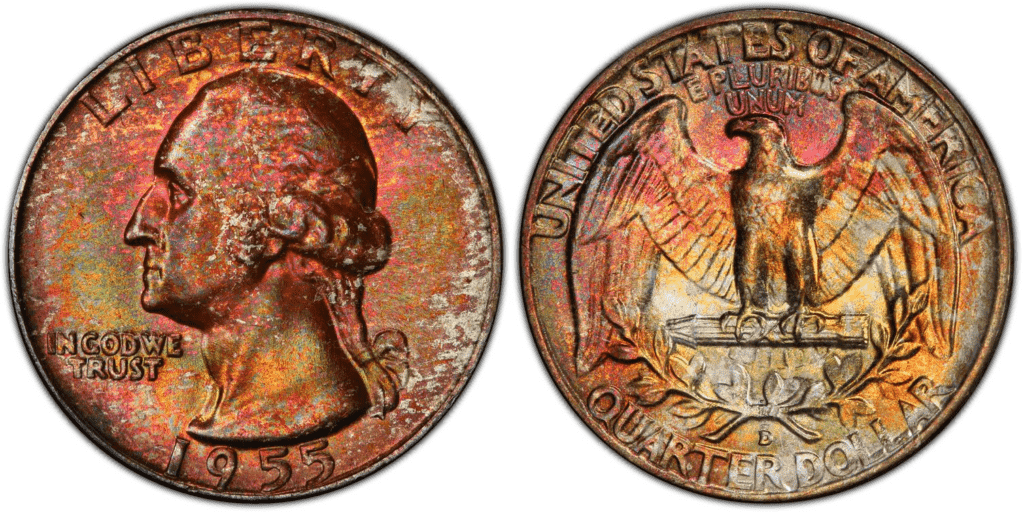
In 1955, the Denver Mint produced more than 3 million silver quarters. Because of the low mintage, a lot of collectors and dealers hoarded the 1955-D quarter. However, this caused the opposite effect. Today, a 1955-D quarter in top grades is easy to obtain and thus, it is not as valuable as people have expected it to be.
1955 P Washington Quarter
Year of minting: 1955
Mint Mark: none
Place of minting: Philadelphia
Quantity produced: 18,180,181
Face Value: $0.25 (twenty-five cent)
Price: starts at around $4.45 and $7 (circulated condition)
Mass: 6.30 grams
Edge: Reeded
Designer: John Flanagan
Composition: 90% silver and 10% copper
Diameter: 24.30 millimeters
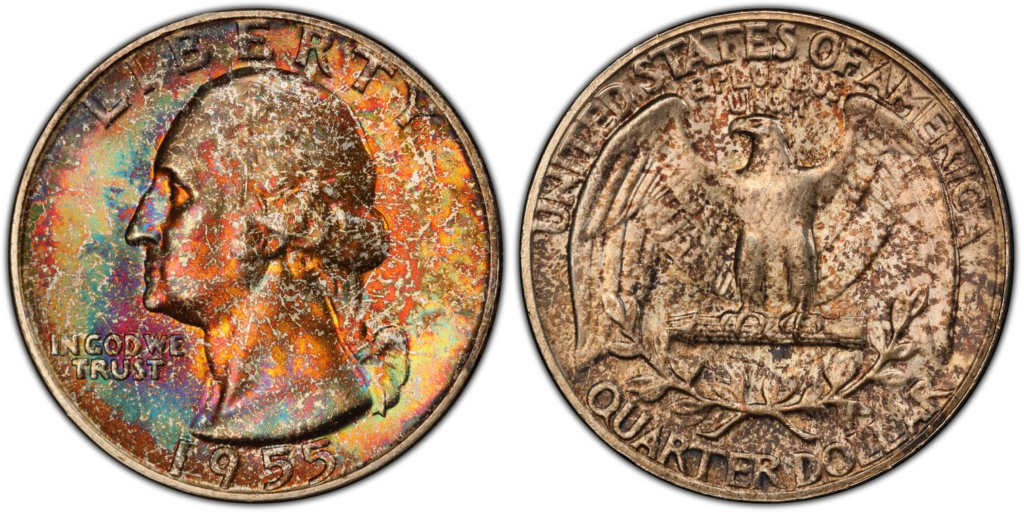
The Philadelphia Mint produced more than 18 million quarters in 1955. The mintage figure might sound low, but the Philadelphia Mint actually produced the most number of quarters in 1955.
There are fewer 1955-P quarters compared to what was minted in 1954 and 1956. The price may start at around $4.45 and $7.
1955 Proof Washington Quarter
Year of minting: 1955
Mint Mark: none
Place of minting: Philadelphia
Quantity produced: 378,200
Face Value: $0.25 (twenty-five cent)
Price: starts at around $17 (uncirculated condition)
Mass: 6.30 grams
Edge: Reeded
Designer: John Flanagan
Composition: 90% silver and 10% copper
Diameter: 24.30 millimeters
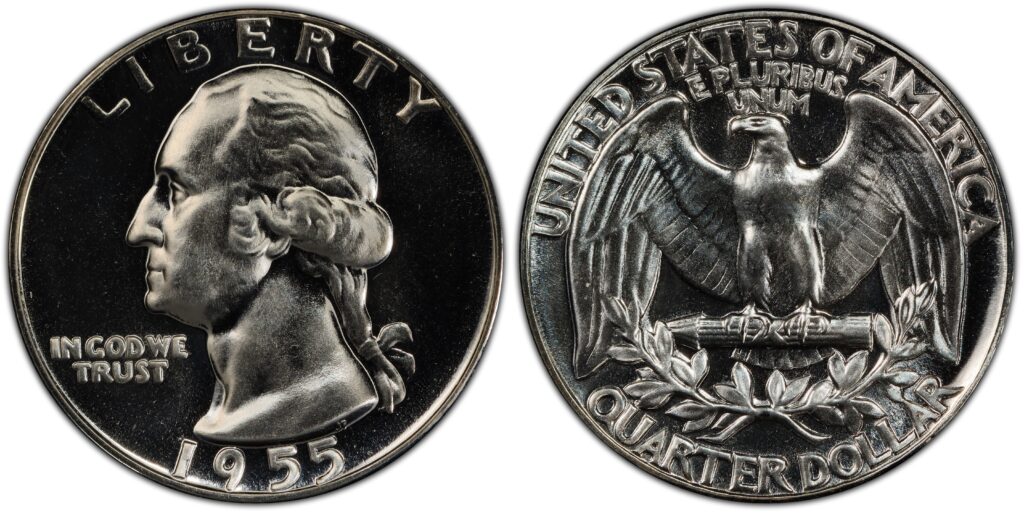
Although the overall mintage figure of the silver quarter in 1955 went down, there was a higher demand for proof silver quarters. From 233,300 proof coins in 1954, there were 378,200 proof coins produced in 1955. There will even be more proof coins produced in the following years.
List Of 1955 Washington Quarter Errors
Why should you be interested in error coins? After all, these coins aren’t perfectly struck coins, right? That might sound plausible as your logical thinking, but the truth is that some error coins are even more valuable than regular coins.
Repunched mintmark
The repunched mintmark (RPM) error happens when the letter die is struck to the blank coin twice. The two strikes are always almost struck in the same place. It’s rare to find a completely separate mint mark. If you find one, then that would surely be super valuable.
Here’s an example of a 1955 Washington quarter with an RPM error:
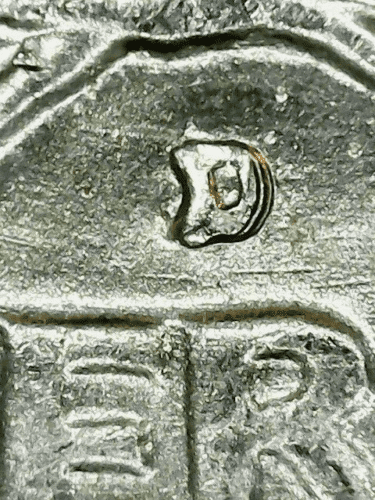
Doubled die error
The doubled die error, as its name suggests, happens when the die hits the planchet twice. Depending on the difference in the angle of strike, a doubled die error can cause doubled appearance on the letters and images on the coin.
The more pronounced the doubled die error, the more valuable the coin gets.
Clipped planchet
Errors can also happen during the cutting of coins. The coin should be a perfect circle. However, because of misalignment in the feeding of the metal sheet, the coin gets clipped.
Here’s what it can look like:
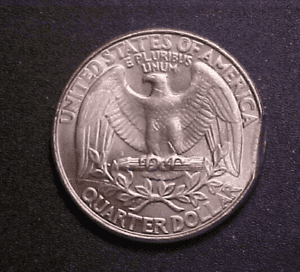
How Much Is The 1955 Washington Silver Quarter Worth Today?
The 1955 Washington silver quarter has a face value of 25 cents. Its melt value is $3.9696, which is higher because of the silver content of the quarter coin. If you’re planning to buy a 1955 quarter in circulated condition, you might spend less than $10 for it.
Nevertheless, there are 1955 silver quarters that are more valuable. Here’s a table of auction records to help you better appreciate its worth:
| Coin | Condition | Grade | Sold date | Sold by | Value |
| 1955 D Washington quarter | Superb Gem Uncirculated | MS 67 | January 7, 2015 | Heritage Auctions | $14,100 |
| 1955 P Washington quarter | Superb Gem Uncirculated | MS 67+ | February 3, 2019 | Heritage Auctions | $12,000 |
| 1955 Proof Washington quarter | Superb Gem Uncirculated | PR 68+ (Deep Cameo) | August 10, 2016 | Heritage Auctions | $3,525 |
How Does The Grading System Work?
The 1955 quarter is graded by using the Sheldon coin grading scale or simply, Sheldon Scale. It is a 70-point grading system that allows appraisers to determine the condition and possibly the value of the 1955 Washington silver quarter.
Along with the Sheldon Scale comes adjectives to quickly describe a coin based on the grade it received. These adjectives may include Basal State, Fair, Very Fair, Good, Very Good, Fine, and so on.
A 1955 quarter can also be referred to as MS or PR. MS means mint state and it is a designation given to coins with grades from 60 to 70. PR means proof and it is a designation given to proof coins. A perfect score would be MS 70 or PR 70.
Professional numismatists joined together in the 1970s and established CoinGrading standards. These numismatists now assign grades at key places on the seventy-point scale, using the most regularly utilized numeric points in conjunction with the original adjective grade. The following are the most common coin grades:
-
-
- (P-1) Poor – Indistinguishable and probably damaged; if used, must have a date and mintmark; otherwise, rather battered.
- (FR-2) Fair – Nearly smooth, but without the damage that a coin graded Poor often possesses. The coin must have enough detail to be identified.
- (G-4) Fair – Inscriptions have merged into the rims in some areas, and important elements have been mostly erased.
- (VG-8) Very Good- A little weathered, but all of the primary design elements are visible, albeit faintly. There is little if any, central detail left.
- (F-12) Good – The item is very worn, yet the wear is even, and the overall design details stand out clearly. Rims are almost completely isolated from the field.
- (VF-20) Very Fine – Moderately weathered, with some finer features still visible. The motto or all letters of LIBERTY are readable. Both sides of the coin have entire rims that are separated from the field.
- (EF-40) Extremely Fine – Gently used; all gadgets are visible, and the most important ones are bold. The finer details are bold and clear, however, light wear may be seen.
- (AU-50) Uncirculated – Slight evidence of wear on the coin’s design’s high points; may have contact marks; eye appeal should be adequate.
- (AU-58) Uncirculated Choice – Slight traces of wear, no severe contact marks, almost full mint shine, and great eye appeal.
- (MS-60) Mint State Basal – Strictly uncirculated; no indication of wear on the coin’s highest points, but an unsightly coin with reduced luster, visible contact marks, hairlines, and other flaws.
- (MS-63) Mint State Acceptable – Uncirculated, but with contact scratches and nicks, little reduced shine, but otherwise appealing appearance. The strike is weak to average.
- (MS-65) Mint State Choice – Uncirculated with great mint shine, very little contact blemishes, and exceptional eye appeal. The strike is unusually severe.
- (MS-68) Mint State Premium Quality – Uncirculated with superb luster, no obvious contact marks to the naked eye, and exceptional eye appeal. The strike is quick and appealing.
- (MS-69) Almost Perfect Mint State – Uncirculated with perfect brilliance, a sharp and appealing strike, and extremely good eye appeal. A near-perfect coin with minor imperfections in the planchet, strike, and contact markings (seen only under 8x magnification).
- (MS-70) Mint State Perfect – Under 8x magnification, there are no tiny imperfections discernible; the strike is crisp, and the coin is perfectly centered on a beautiful planchet. Rarely seen on a coin, this coin is bright and whole, with original luster and exceptional eye appeal.
-
Where To Buy Or Sell 1955 Washington Silver Quarter?
The Washington silver quarter can be difficult to find. So, the best way to find them would be on the Internet. You can go to Google, and type in “where to buy 1955 quarter” or “Where to sell 1955 quarter.” You should quickly get a list of options.
The problem here is that you don’t actually get to see the coin in person. So, you need to rely on videos or pictures. Aside from that, be sure you only transact with reputable and trusted vendors so you avoid getting scammed.
If the Internet is not your thing, you can visit coin shops, antique stores, and pawnshops. You can also get in touch with coin grading service providers such as PCGS and NGC. For example, PCGS has authorized dealers across the country.
If you can, join auctions, which are known to feature some of the rarest coins. You might also want to consider joining local clubs or groups of coin collectors. The more people you know, the more chances you’ll find people who might want to buy your coin or find people who are selling 1955 silver quarters.
FAQs
Is a 1955 quarter pure silver?
No, the 1955 quarter is not pure silver. Instead, it is made of 90% silver and 10% copper.
Is a 1955 silver quarter worth anything?
Yes, the 1955 silver quarter is worth a few dollars. Since it is made of silver, its intrinsic value is higher than those coins made of base metals. Moreover, rare quarters in great condition may also be more expensive. To give you an example, a 1955 D Washington quarter, with a grade of MS 67, was sold for $14,100 in January 2015.
How much silver does a 1955 quarter have?
The 1955 quarter contains 0.1808 oz of silver with a fineness rating of 0.9.
